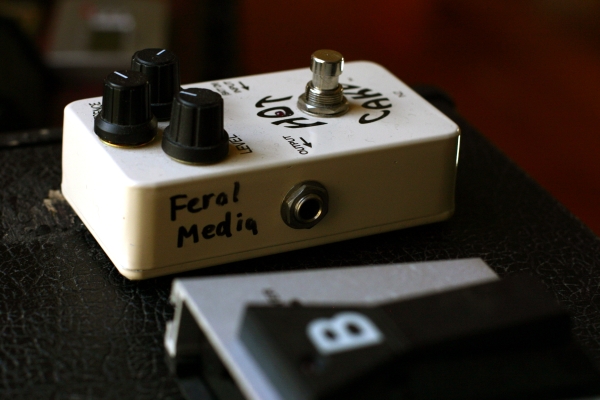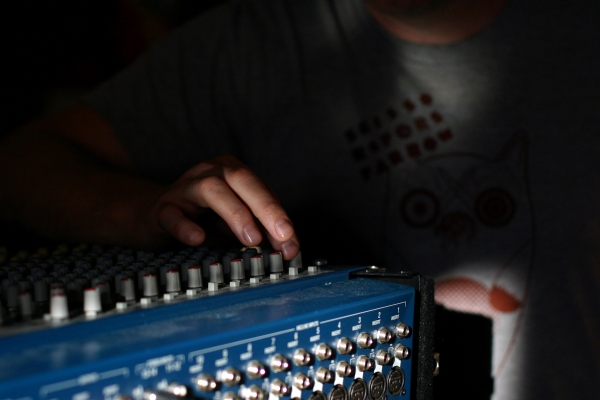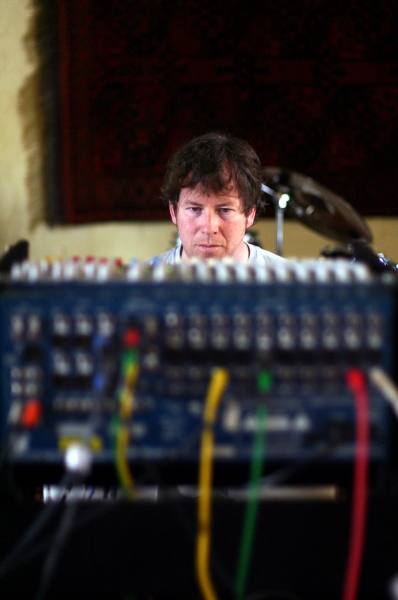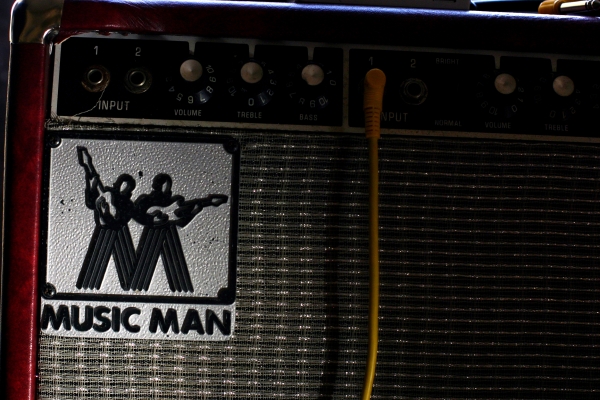Danny Jumpertz’s studio is no regular studio, and don’t go looking for the phone number to book it for your next recording because it’s not that kind of place. It’s a place where artists on his Feral Media label go to rehearse and record, where songs get mixed, and sometimes where music fans in the know congregate for intimate secret gigs of visiting electronic artists.

(pics by Benjamin Millar)
On this particular day, it’s also a place where there’s evidence of visiting kids running through the studio to get to the pool just outside the glass door, and a step-ladder leading to a pair of congas so the same kids can get musical when the moment takes them. Not only is this Camperdown warehouse the headquarters of Feral Media, which Danny co-runs with his wife Caroline Chisholm, but it’s also their home.
“It’s a flexible space,” says Danny from behind his mixer and computer. “We’ve had some good little social evenings where people just get together and talk about music. If various artists were in town they could perform here because all the gear was quick to set up and play. That’s worked really well and we’ve done a couple of launches in here as well. Plankton played in here when they were launching Insomnia, and also Barrage. Actually, when I was first making tentative steps to do my own stuff, I played upstairs to a whole bunch of friends.”
He also says that the space has worked really well as the administrative headquarters of Feral Media too, “just for doing little working bees like putting together CDs and things like that. It’s good to have a functional space for sewing the labels and stuffing the CDs and all that sort of stuff. There always a real variety of activities happening from here. Yeah, it’s great.”
A long table with a Mac and a mixer is the focus of the large rectangular room. A drum kit and a row of guitars sit behind Danny atop a Persian rug. Another Persian rug is draped on the wall behind the drums and red paper Chinese lanterns dangle from the roof beams. Amps and other larger bits of gear are scattered around the room with patches of floorboards gleaming in between. The walls are lined with boxes of leads, stationary, Feral Media merch’ stands, recording toys and Danny and Caroline’s CD collection (including Rolling Stones albums signed by Mick Jagger himself).”

The studio’s got to be a welcoming space. I like things in balance and in harmony and it’s a reasonably large space so it can easily get very cluttered if you just keep on piling stuff in here. I change it all the time. I move things around and it’s sometimes in those moving around phases that you’re disengaged from ‘in-front-of-the-computer’ mode. You get off your backside and realise how a space can be changed or moved or set up a bit differently to make it more productive.”Always having the room set up and ready to use is important to Danny. “It’s good to have a short space of time from having an idea to being in record mode. If you can get to that stage in under 30 seconds you’re on your way, I reckon. If you have to unpack everything and set it up then sometimes the vibe is just completely gone. That’s the advantage of having space. You can have shit out for a long time and set up like it is now. We could have a jam now and have something down in 15 minutes.”
When used for recording the space is very much about capturing the moment. Being one large room, it’s impossible to separate each instrument during the recording process so instead the focus in on getting a good take of the entire band and then working with all of those elements in post-production, much more like in a live recording.
“I think you just need to try and capture what’s happening in the room accurately. In a space like this with a three-piece band everyone would be playing together and everything is spilling into everything else anyway. I’m not one for great sonic isolation – you’ll hear the drums in the guitar amp and all that sort of stuff. The main things to consider would be: is the take good and are they playing well? You’re better off having people playing well and capturing it on whatever is available rather than having a pristine recording of something that hasn’t got any soul.”

This has always been Danny’s goal and the basic need to capture a moment with whatever setup is available has lead to his current studio environment. “We’d very rarely go into a recording studio,” he says of the various projects he’s been involved with lately. “This studio was just a resource we could provide to get records out cheaply without having to spend too much in the recording phase.”
Danny first got into recording with analogue gear as a teenager after attending an audio engineering school and then getting a job at a local radio station. It was his later investigations into recording through Plankton, after studying digital recording at Southern Cross University, that have landed him where he is now.
“I recorded the Plankton album and mixed it. That was probably the start of this as a home base recording set up. We did most of the recording in rehearsal studios and this would’ve been between 2001 and 2002 and it was at this point that digital technology was cheap enough and laptops were reliable enough to take into rehearsal studios and just start recording in that way. All the mixing I did was at home and then when we moved to Sydney (from Melbourne) I continued that but had a much bigger space so I started doing some tracking as well, not just mixing – although it’s probably better as a mixing space than a recording space. It’s a fantastic room but without an isolated control room. When you’re doing tracking with the band you’re in the same space as them and actually that’s really fun. You can’t monitor things really well as they’re being recorded but as long as the levels are OK. You’re in amongst it so that’s really good.”
The studio is constantly evolving in small ways but Danny claims to be over the initial “gear-buying frenzy” citing that it’s important to get the basics right.. “I think one of the most important things you can have in a studio is reasonable monitors because they basically are the screen through which you see everything. These speakers, Genelec 1029As, probably cost just as much as the software interface. They are near field monitors, small monitors, but they’re really clear and give you an accurate picture. There are two of them and a sub underneath. Together they provide a really balanced picture of what you’re doing and I think that’s the most important thing. Also it’s good to get a good pair of headphones. When you’re mixing in a small room you can get quite an accurate picture from a good pair of earphones. Not so much in the bottom end, but you can still get a good balance.”
A less typical item he uses in his studio are PA speakers, the kind you’d see at a small gig. “They’re handy with mixing too because it gives you a different sonic picture than a good clear near-field monitor would. It sounds more like it would at a live venue or a gig and you can get a good snapshot of whether a track is working by switching between the monitors.”
In looking over the equipment his eyes next land on his mixer. “A good mixing desk is really essential. A lot of people who do home recording with computer sound cards that don’t have good mixers hit a lot of problems with getting the right signal to level into the computer. It’s just a good way of combining all the different sources when recording and also when you’re listening back. Depending on how you set it up, and that’s the beauty of a mixer, it’s very flexible.”
Danny’s studio tour continues through smaller pieces of equipment: “I suppose the other bits and pieces which I use a lot are the tape delay units, the space echo machines, and they’re just basically effects devices you use to just colour and change the sound, providing different types of modulated effects like chorus, delays, echoes, EQing, pre-amping, overdrive and all that sort of stuff. I use them on everything to colour things. I plug in guitar, drums, vocals, a lot of guitars actually, but I’ll also create something on the computer, like in Ableton Live and then output it into the soundcard of the computer, into the delay unit or for reverb and then bring it back, then get rid of the original unaffected track and just use the affected track.
“Mics are always the next step. I don’t have tonnes of good mics but I’ve got enough to get a rhythm section of a band sounding good. This is an unusual mic that I bought,” he says, pointing to a large mic with a ‘droid head’ shape. “It’s like a stereo PZM mic and it’s mainly used for location sound recordings and stuff like that. People often attach them to cameras to provide a very neutral and natural flat sound. The good thing about them is that they’re very good with bottom-end response, they work differently to a dynamic or condenser mic, they’re a lot more robust and the stereo imaging is very good, it’s very natural. They’re really good with things which are loud so you can put it really close to the kit and it doesn’t distort. I’ve used that setup to basically record the whole kit. Just one stereo mic on the kit and it gives you a really good cohesive picture.”

It just goes to show that in setting up his studio Danny hasn’t followed any how-to books but rather has gone with what he feels is right. “That’s what I’ve got and that’s the way I’ve used it (the PZM mic) and it’s worked well so I just keep on using it, but I haven’t ever seen anyone else even use one of these sort of mics in the studio.”
Working with available resources is a common theme throughout the studio. “The space really dictated what we could do in here.” Before being a studio the space was the warehouse lounge room, but its size made it the best choice of room to turn into a home studio. “We put in that wall in which is dividing the studio from the kitchen and lounge room space, and put that door in with double glazed glass. We got in a guy who had set up recording studios in England and was actually working at 301 as an acoustic consultant. He said ‘This is what I would do: you’re not gonna get this place completely sound-proofed without spending shitloads but these are the things I would do’,” Danny and Caroline took his advice and put in double-glazed doors and windows, double doors and redid the ceiling.
“If we were doing a lot of music in here it would just go straight up into the bedrooms. A friend put a ceiling in but with little supports which were separate from the roof above. Having that space there is sort of a buffer to the laneway. It’s pretty well acoustically isolated and it was also fine for, y’know, we could make a noise in here and it was reasonably quiet without too much sound leaking out.”
What’s most important to the recordings which come out of the Feral Media studio is not the gear but Danny’s approach to recording music. “Obviously, sometimes not having some gear can hold you back and for a while there I couldn’t really do professional recordings because I didn’t have the right gear but once you’ve got it you just need to sit down and use it and use it well. I suppose you also need to have a good clear idea of what you want to get down and just be ruthless with the stuff that you do. Really, don’t become too attached to things in early stages because if they’re not working sometimes you just need to move on or do something quite drastic to make it work. That’s more about where your head’s at rather than what sort of gear you’ve got. If you’ve got a good take in the can then you’re more than halfway there. The energy of the take is what’s going to make it stand out in the big bad world. Capture something that’s just got some kind of vitality because that’s so often what is missing from recordings.”



